
Born from Pain, Raised in Love
The birth of Buddy Jr.—whom everyone later affectionately calls “Stump”—is not a joyful celebration but a bittersweet turning point in Fried Green Tomatoes. Ruth Jamison is pregnant with the child of her abusive husband, Frank Bennett, a man she escaped with the help of Idgie and their friends. In a time and place where a woman’s worth is often tethered to her role as a wife and mother, Ruth’s decision to keep and raise her child outside the traditional nuclear structure is radical.
More than just a baby, Buddy Jr. represents something larger: the endurance of women’s agency. Though conceived in violence, he is not a symbol of Ruth’s suffering—he becomes a symbol of hope, healing, and chosen family. His arrival is a defiance of despair, a declaration that a better world is possible, even in the Deep South of the 1930s.
Idgie’s Transformation into a Parent
Though Ruth is the child’s biological mother, it’s Idgie Threadgoode who steps seamlessly into the co-parenting role. In a society where same-sex couples could not exist openly and where women were rarely permitted autonomy, the life Ruth and Idgie build is subversive in its quiet resilience. They raise Buddy Jr. as their own, not with public declarations but through daily acts of love, care, and shared responsibility.
Idgie teaches Buddy Jr. how to fish, how to climb trees, how to laugh, and how to survive. She becomes a father figure by every measure except name. The townspeople of Whistle Stop may never question their arrangement aloud, but it’s clear: Ruth and Idgie are building something that transcends traditional definitions of family.
Buddy Jr.’s childhood reflects this love. He grows up surrounded by community, kindness, and independence. He is not defined by the absence of a father or the trauma of his origin. He is defined by presence—of his two mothers, of Sipsey and Big George, and of the people of Whistle Stop who never let the past overshadow the promise of the present.
The Train Accident: A Generational Echo

One of the film’s most emotionally devastating moments is Buddy Jr.’s train accident. In an eerie mirror of his namesake Buddy Threadgoode’s death, the young boy loses his arm while playing on the tracks. The visual symbolism is haunting—Buddy Jr. reaching for his hat, the screech of the train, the helplessness of the adults.
This scene is not just tragic—it’s traumatic in layers. For Idgie, it rips open the wound of losing her brother all over again. For Ruth, it is a mother’s worst fear realized. For the audience, it’s a harsh reminder of the uncontrollable forces in life—violence, machinery, fate.
Yet the aftermath of the accident reveals the soul of the film. Buddy Jr. survives. He is resilient. His new nickname, “Stump,” becomes a badge of honor, not pity. He continues to climb trees, to smile, to live fully. His disability is never framed as limitation—it’s presented with dignity, as part of who he is, not what holds him back.
Community Support and Collective Love
After the accident, Whistle Stop does what it does best—it pulls together. The townsfolk don’t ostracize Buddy Jr. or his mothers. They don’t whisper or shame. They show up with food, with laughter, with acceptance. This reflects the unspoken power of chosen families and communities of care, particularly in times of hardship.
The café remains a hub of life. Ruth and Idgie continue running it, and Buddy Jr. continues being a part of it. His presence is more than sentimental—he’s woven into the very identity of the town. Through his smile, his determination, and his unbreakable spirit, the people of Whistle Stop find their own strength.
The Name That Bridges Past and Future
Naming the child “Buddy” is no accident. It’s a tribute to the brother Idgie lost, a way to keep him alive in spirit. But Buddy Jr. is not just a shadow of the past—he becomes his own person. He is playful, mischievous, and full of warmth. In many ways, he’s the bridge between generations: a living thread connecting Ruth and Idgie’s love to the memory of Buddy Threadgoode.
The film never gives us a full view of his adult life, but that’s intentional. Buddy Jr.’s role is not to carry the plot—it’s to carry the legacy. By surviving, by thriving, he becomes the proof that love outside convention can bear fruit. That chosen families can endure. That even in a world scarred by violence and loss, joy finds a way to grow.
The Silent Enduring Legacy
What makes Buddy Jr. so compelling is not just his story—it’s the way the film handles him. He is never objectified as a tragedy. He is never used as a symbol of pity. He is simply a boy—loved, injured, healed, and loved again. His story adds layers to Ruth and Idgie’s relationship, giving it depth and longevity beyond romantic subtext.
He is the boy who grew up in a café that defied racial and gender norms. The child who lost an arm and never lost his smile. The boy who, in many ways, kept his mothers’ spirits alive after Ruth’s death.
Conclusion: A Life Worth Fighting For
In the end, Buddy Jr.—Stump—is more than a supporting character. He is a quiet revolution. His existence proves that life after trauma is possible. That families don’t have to look one way to be valid. That disability does not mean weakness. That being born from violence doesn’t doom a child to repeat it.
He is a boy born into a broken world who learned to climb trees with one arm.
He is Ruth and Idgie’s love, made flesh.
He is the legacy that lives on.
